Apple iPhone 4S: Thoroughly Reviewed
by Anand Lal Shimpi & Brian Klug on October 31, 2011 7:45 PM EST- Posted in
- Smartphones
- Apple
- Mobile
- iPhone
- iPhone 4S
Battery Life
I'll begin this section with an admission: we need to update our battery life suite. With the introduction of the very first iPhone I introduced a web page loading test that simply cycled through a bunch of web pages, pausing on each one to simulate reading time (I measured how long it took me to read a typical content page and used that as the reading time). Our web browsing battery life test is largely dominated by the power consumption of the display, but it also causes the CPU to wake up from its low power states and hits the WiFi/cellular stacks as well. The test managed to do reasonably well over the years however it's getting a bit long in the tooth, especially given that mobile browsers have become more aggressive in caching content. The move to iOS 5 in particular hurt our web browser test as it cached so much of the content of each page that our cellular results now closely mirror our WiFi results on the iPhone 4/4S. There's still a bit of a penalty to be paid over 3G, but not nearly as much as it should be in the real world. The test data is still valid, it's simply no longer representative of real world web browsing battery life, but rather a more academic look at very light (but continuous) smartphone usage. Thankfully we do have other tools at our disposal until we update the web browsing suite. Brian Klug devised a hotspot test that really stresses the cellular baseband of these phones by constantly streaming content over the Internet, via the phone being tested, to a tethered notebook. Between our hotspot, web browsing and call tests we should be able to get a good idea of the overall performance of the iPhone 4S on battery.
Before we get to the results, let's talk a little bit about what we should see architecturally. As Brian already mentioned at the start of the review, battery capacity is up slightly in the iPhone 4S. The increase is marginal at best, on the order of 1%, meaning it shouldn't result in a tangible impact to battery life.
The display is a major consumer of power but with the specs unchanged since the original iPhone, the 4S' panel shouldn't consume any more power than its predecessor. This leaves the A5 SoC and the Qualcomm MDM6610 baseband as the primary influencers on power consumption.
Process technology hasn't changed going from the A4 to the A5, both chips were built using Samsung's 45nm process as far as we know. At the core level, a single ARM Cortex A9 core is about 10 - 50% faster than a Cortex A8 at the same frequency. Thankfully Apple kept frequency constant with the move to the A5 in the 4S, making this comparison a bit easier to make.
NVIDIA originally told me that the Cortex A9 was more power efficient than the A8 it replaced. The A9 has a shorter, more efficient pipeline and, in the case of the A5, isn't pushing ridiculous frequencies. Based on Apple's frequency targets alone I'd say that it's probably a safe bet that we're looking at a 45nm LP implementation.
To claim the A9 is more power efficient than the A8 isn't enough however. If we look at Larrabee and Intel's first five years of Atom it's clear that when faced with the ultimate goal of minimizing power consumption, an in-order core is the way to go. In the ARM space, the recently announced Cortex A7 offers an additional datapoint: when ARM needed a low power core, it picked an in-order design with an 8-stage pipeline. The additional hardware required by an OoO architecture consumes significant power, and the gains in performance aren't always enough to offset the corresponding increase in power.
Why would being faster make a microprocessor use less power? The concept is called race to sleep. At idle the CPU in an SoC is mostly clock gated if not power gated entirely. In this deep sleep state, power draw is on the order of a few milliwatts. Under full load however, power consumption can be well above a watt. If a faster processor consumes more power under load but can get to sleep quicker, the power savings may give it an advantage over a slower processor. Consider the following examples:

Here we have two hypothetical CPUs, one with a max power draw of 1W and another with a max power draw of 1.3W. The 1.3W chip is faster under load but it draws 30% more power. Running this completely made-up workload, the 1.3W chip completes the task in 4 seconds vs. 6 for its lower power predecessor and thus overall power consumed is lower. Another way of quantifying this is to say that in the example above, over 10 seconds CPU A does 5.5 Joules of work vs. 6.2J for CPU B (assuming both chips have the same 0.05W idle power consumption).
Now let's take the same two hypothetical CPUs and present them with a workload that doesn't scale nearly as well on the faster part:
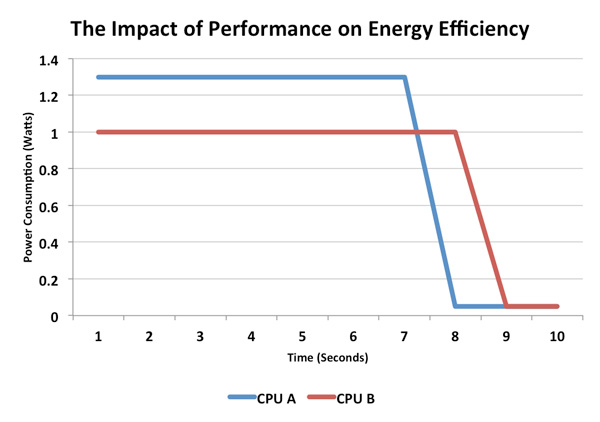
Despite being faster, the 1.3W CPU isn't fast enough to overcome the 30% increase in power. Here CPU A does 9.25J of work vs. 8.1J for CPU B. Perhaps the faster CPU has more cores and the workload isn't well threaded, or maybe the workload is more optimized for the slower architecture, regardless of the reason this is just as valid of a scenario.
Albeit overly simplified, these two cases are examples of what could happen between the iPhone 4 and iPhone 4S. ARM hasn't published a lot of data comparing the Cortex A8 to A9, but ARM has publicly stated that a single A9 core can consume 10 - 20% more power than a single A8 core. If we assume those numbers are under max load, then the A9 simply needs to be more than 10 - 20% faster than the A8 in order to come out ahead. As we've already seen from some of our benchmarks, that's not too difficult, particularly in web browsing. But in other tests, the advantage is more marginal.
The comparison becomes more complex when you take into account there are two Cortex A9s in Apple's A5 SoC vs. a single Cortex A8 in Apple's A4. This is potentially an advantage as a well threaded app could run both cores at a lower voltage/frequency combination (reducing power at an exponential level) while the single core would have to run at its maximum voltage/frequency levels.
It's also possible than two cores would consume more power, but for that to happen you'd have to be running a heavily threaded app at full frequency for a considerable amount of time. To date I haven't seen many smartphone apps that would create such a scenario, but it's akin to looping Cinebench on a quad-core vs. a dual-core part and noting a reduction in battery life for the quad-core CPU. Although the former is quicker to complete the task, the fact that you're looping it indefinitely prevents its speed from ever being an advantage for battery life.
I crudely measured power consumption on the iPhone 4 and 4S (both on AT&T) doing a variety of tasks. The granularity of my measurements is what makes them crude, I was limited to a resolution of 0.1W. While this data would've been far more useful given 0.01W resolution, we are able to use it to get a general idea of power consumption between these two phones. I briefly contemplating inserting a multimeter in-line with the battery however I chickened out, not wanting to risk damage to my phone or review device. I highlighted the obvious power advantages although keep in mind some of these advantages may be smaller (or larger) than they appear due to the 0.1W resolution of my measurements:
| Power Consumption Comparison | ||||
| Apple iPhone 4 (AT&T) | Apple iPhone 4S (AT&T) | |||
| Idle | 0.7W | 0.7W | ||
| Launch Safari | 0.9W | 0.9W | ||
| Load AnandTech.com | 1.0W | 1.1W | ||
| Maps (Determine Current Location via GPS/WiFi) | 1.3W | 1.4W | ||
Power at idle and during application launches was pretty much unchanged between the two devices, which is to be expected. The 4S did draw measurably more power loading web pages. As we've already seen however, the average performance gain in our web page loading tests was over 30%, easily making up for the increase in power draw here. Maps however pulled more power on the 4S.
What does all of this mean? The iPhone 4S has the potential to have slightly better, equal or much worse battery life than the iPhone 4. It really depends on your workload. If you're mostly browsing the web, the 4S should be about equal to if not slightly better than the 4. Our numbers seem to back that up:
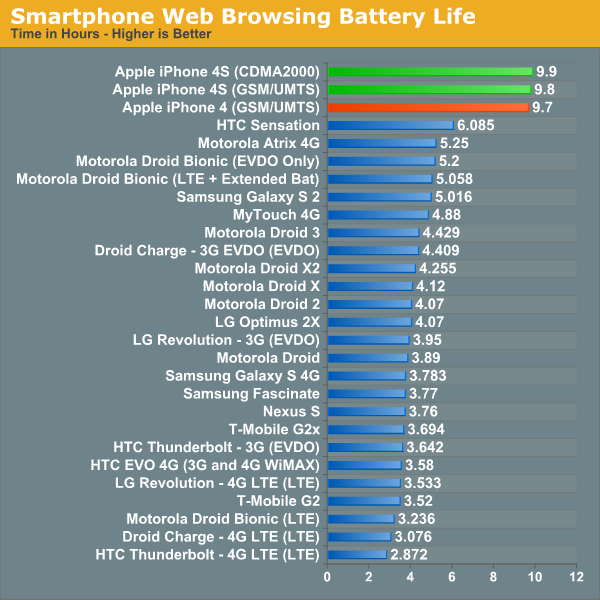
Even though the 3G results are skewed by an unrealistic amount of caching, the CPU still has to work to render and display each page. Since the workload remains the same between the iPhone 4 and 4S, the latter simply enjoys a performance improvement (pages load quicker) while extending battery life a bit thanks to being asleep for longer.
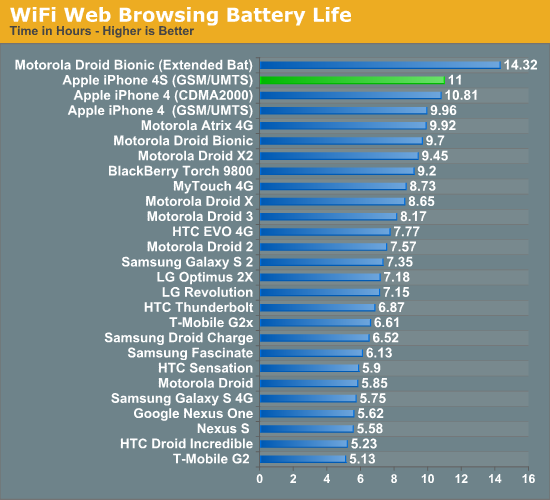
There is one caveat to web browsing battery life: the 4S will only last longer if you do the same amount of work on it. Typically, if web pages load quicker, you end up browsing more on the faster device than you would on the slower device. If you do browse more on the 4S as a result of its speed improvements, battery life won't be as good as it was on the 4. There's nothing you can do about this - faster CPUs and faster Internet connections have always encouraged faster browsing, but it's something to keep in mind if you make the upgrade.
3D Gaming Battery Life
| Power Consumption Comparison | ||||
| Apple iPhone 4 (AT&T) | Apple iPhone 4S (AT&T) | |||
| Launch Infinity Blade | 2.2W | 2.6W | ||
| Infinity Blade (Opening Scene, Steady State) | 2.0W | 2.2W | ||
Infinity Blade is a GPU intensive 3D game, which obviously causes the GPU transistors to fire up on both SoCs. Given the beefier GPU in the 4S, much higher power consumption here isn't unexpected. Since battery capacities haven't really changed, and the 4S does draw significantly more power under heavy GPU load (even limited by Vsync), you can expect lower battery life when running GPU intensive 3D games. To put some real world numbers to the data I ran a loop of Epic's Citadel demo on both the 4 and 4S until both phones died:
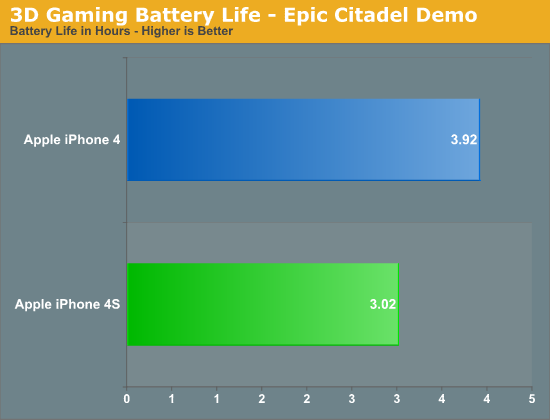
The iPhone 4 lasted around 30% longer in our GPU test compared to the iPhone 4S. This is actually a trend we have seen before, with the move to the 3GS we noted a similar impact on battery life compared to the previous iPhone 3G. If you're going to do any heavy 3D gaming, expect the iPhone 4S to burn through your battery quicker - although you will have a better experience on the 4S thanks to a smoother frame rate. Note that for sufficiently light 3D workloads (e.g. where the iPhone 4 is already bumping into Vsync), it's unlikely that you'll see much of a difference in battery life between the two phones. Citadel is simply too strenuous of a test for the 4. What really penalizes the 4S is its ability to run at nearly 2x the frame rate of the 4.
| Power Consumption Comparison | ||||
| Apple iPhone 4 (AT&T) | Apple iPhone 4S (AT&T) | |||
| Launch iBooks | 1.3W | 1.2W | ||
| iBooks Page Turning Animation (Rapid Movement) | 1.6W | 1.5W | ||
If you're concerned that GPU acceleration throughout the OS will penalize the 4S, I wouldn't be too worried. The data above shows power consumption while running iBooks. For the second test I took a book page and quickly moved it left/right to trigger the ever impressive page turning animation. Doing so drove power consumption up, but the 4S consistently pulled less power than the iPhone 4. If you're going to be at the forefront of 3D gaming on iOS, the 4S won't last as long as its predecessor. For casual use, you should be just fine.
3G/WiFi Battery Life
I ran several speedtests in the same location on both 3G and WiFi to see if I could get a clear idea of whether or not the baseband and WiFi stack in the 4S was more power efficient than in the 4. The results unanimously agree, the 4S is more power efficient at uploading/downloading at the limits of 3G and WiFi:
| Power Consumption Comparison | ||||
| Apple iPhone 4 (AT&T) | Apple iPhone 4S (AT&T) | |||
| Speed Test (3G, Downstream) | 2.8W | 2.4W | ||
| Speed Test (3G, Upstream) | 3.0W | 2.8W | ||
| Speed Test (WiFi, Downstream) | 1.5W | 1.4W | ||
| Speed Test (WiFi, Upstream) | 1.6W | 1.4W | ||
Our tethered test gives us a good idea of how quickly the 4S will die under moderate cellular data load. Apple's power advantages under iOS are due to wonderful management of idle time, similar to what we've seen with OS X vs. Windows 7. Under load however, Apple is bound by the same physical realities as its competitors and the question of battery life becomes one of battery capacity divided by peak power draw. Here the iPhone 4S does very well, but it's outpaced by the upper echeleon of Android phones:
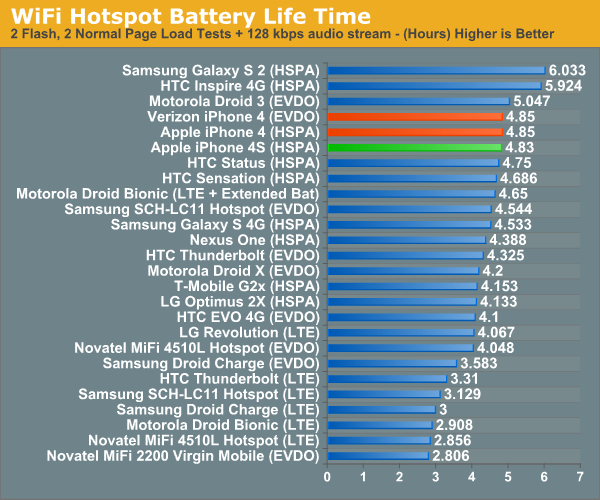
It is surprising that despite the peak power advantages above, we didn't see any improvement in our WiFi hotspot test. The only explanation I have is that the power advantage may not be as pronounced if we're not pushing the limits of the wireless interfaces.
Call time, on the other hand, improves tangibly compared to the iPhone 4. As the screen is off and the CPU mostly idle during this test, it really just echoes the numbers we saw above. Qualcomm's MDM6610 seems to outclass the outgoing Infineon X-Gold baseband when it comes to power efficiency:
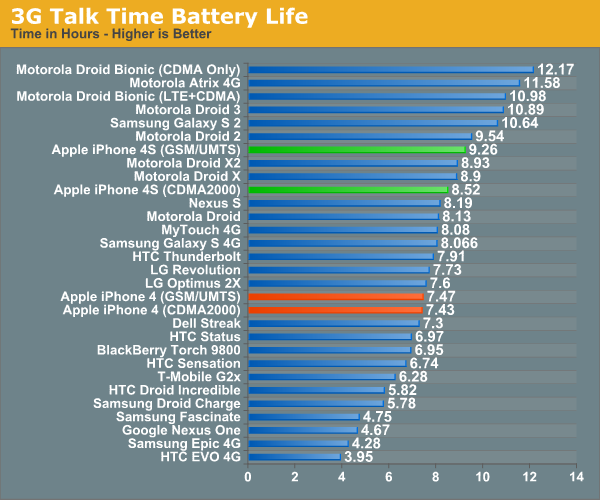
Based on the data we have here, I'd say Apple's claim of 8 hours of battery life is fairly realistic under some sort of continuous use/load. If you're constantly pulling data don't expect to see more than 5 hours, but if you're mostly reading/watching/consuming content you will get closer to 10 hours on the iPhone 4S. Call time falls at the longer end of the spectrum, but be warned: run a demanding 3D title and you'll see barely over 3 hours of use out of the iPhone 4S. It looks like any serious 3D gaming is going to have to be tethered or at least near a power outlet. The move to 28/32nm should buy us some more power headroom, but then again there are even faster GPUs just around the corner.
Based on our data, concerns about the iPhone 4S' battery life seem unrelated to hardware. The raw power consumption numbers show a platform that's competitive with its predecessor in most areas, only really hurting when it comes to heavy 3D workloads. If you're seeing worse battery life on the 4S, the cause would appear to be software related. Wipe, setup from scratch (no restore), remove/re-add all accounts and reset network settings would be the best course of action if you're seeing higher than normal power consumption.
Moving forward, I wouldn't be too surprised to see battery life remain around this level for the near future without significant advancements in battery or process technology. As we look toward the next-generation of microprocessor architectures, they simply become more robust out-of-order designs. As we've learned from the move to multi-core on the PC side however, continued gains in single threaded performance become increasingly difficult to come by - particularly without expending a lot of energy. There is hope for an increase in efficiency via heterogeneous multiprocessing, but just how much that will buy us remains to be seen. Process technology and architecture are going to become even more important over the coming years in the mobile space.










199 Comments
View All Comments
ados_cz - Tuesday, November 1, 2011 - link
I have the 4S now and the problem is gone but once my girlfriend comes with her 4, I will make a video and post it to prove you wrong. People have no problems only in areas where signal is really strong. Why would I possibly want to lie?wonderfield - Tuesday, November 1, 2011 - link
What's of concern here is not whether the issue (signal loss) can be demonstrated but whether the phone is, in Brian's/Anand's words, "usable" with the defect or not. It's certainly possible for the GSM iPhone 4 to be rendered unusable in a low signal strength area with a natural, right-handed grip just as it can be rendered unusable with a death grip. That's not to say the phone will be unusable in most scenarios, however, because in most scenarios the phone should function properly. There are certainly edge cases, and the issue is more significant for those who're left-handed and for those who live/work in very poor coverage areas (where it can become an issue), but, again, that's not the typical use case. It's why I categorize Brian's claim that the GSM 4 is not usable without a case as being disingenuous.Realistically, you don't need a "really strong" signal to have not have any problems with the phone, you only need a signal great enough to overcome any attenuation introduced by making contact with the antenna. The extent of the attenuation, as demonstrated in another Anandtech article to which you might refer, is not as significant as portrayed by some media outlets.
ados_cz - Tuesday, November 1, 2011 - link
As far as the need for good signal went I needed to use the case all the time otherwise I would always have to hold the phone in unnatural way. iPhone 4/S is a really beautiful piece of hardware and It was really upseting that I had to use the case and spoil the desing. My close friend living just 15 miles next to me in Perth does not use the case and when he does not care to not to hold the phone in sensitive area, the call drops. It happend to me with him on the phone on few occasions. Few of my friends at uni need to use the case for iPhone 4 as well. The problem was not overstated. Either learn to hold the phone unnaturaly avoiding joining those two critical antenna strips or use a case. I opted for a case. My friend in the London got on well without case, but he learned to hold it by the to when calling. Anyway, I am glad that I have the 4S now and I think my girlfriend does not mind the case on her (former mine) iPhone 4. It so well made piece of hardware and so affordable here in Britain. You are being ripped off in US. Check the deals for iPhones on www.three.co.uk I got mine iPhone 4 for 69 pounds 5 months ago with two years contract for 35 pounds a month (2000 mins any network, 5000 mins mine network, unlimited 3G data with no fairu user policy). I paid 189 pounds for girlfriends (now mine) 4S for 32GB white version just few days ago and she got the same 35 pounds contract.Tetracycloide - Tuesday, November 1, 2011 - link
"I have hundreds of friends who have iPhone 4's who've never had any issue with signal loss at all."Really? Name them. Numbered from one to at least two hundred if you please.
Overstating the strength of your anecdotal evidence doesn't make you look right it makes you look biased.
For what it's worth, I think you're a huge tool for, well, being such a huge tool.
doobydoo - Wednesday, November 2, 2011 - link
Don't be ridiculous.To label someone a 'tool' for stating that their friends don't have issues with signal loss on a phone, is quite frankly ironic.
To suggest I would list my friends names in a bid to convince such a low level individual is even more ridiculous than the rest of your comment (which is a lot).
If you really need hard evidence, I'd point you in the direction of the millions of iPhone customers who gave the iPhone 4 the highest satisfaction ratings of any phone, full stop. Bit hard to imagine that happening if they cant make calls on it, don't you think?
To claim I'm overstating my quite logical claim doesn't make you look right, it makes you look biased.
Tetracycloide - Wednesday, November 2, 2011 - link
I labeled you a tool because your response to another commenter saying they experienced an issue you and 'your friends' never saw was 'your a liar' or more literally "For what it's worth, I don't believe you anyway." That's where you were a tool, that part right there.Your 'hundreds' comment was absurd and you know it. To obtusely pretend I'm actually asking you for a list of names and act like that's absurd (it was obviously rhetorical) is to miss the point which was: you do not actually have 200+ individual examples from 'friends' to draw from. That's absurd.
Your claim was hardly 'logical' it was an absurdly overblown statistic that, even if it was accurate, would still be anecdotal. As are you're 'millions of iPhone customers' by the way. The phone looses signal if held incorrectly. That is the objective reality, full stop.
doobydoo - Friday, December 2, 2011 - link
How ironic that your justification for calling me a tool, is that I essentially disbelieved someone else, after that's all your comments to me are based on.Not only that, but how ridiculous and illogical to say someone is a tool for not believing something. Grow up?
'Hundreds' is not absurd at all, perhaps it sounds absurd to a social recluse? But I can actually name at least 200 friends of mine who use iPhones. Sorry if having friends is a strange concept to you. How dare you claim that you 'do not believe' my 200+ friends claim - that makes you a tool (it's a definition handed down to me by someone special).
Even if my claim was anecdotal, so what? Your criticism of my claim wasn't that it was anecdotal, and I never masqueraded it as anything other than what it was?
The 'MILLIONS' of iPhone customers is not anecdotal at all, by the way - they HAVE factually given the iPhone 4 the best user ratings of any phone of all time. That's reality, fact, pure and simple. They wouldn't do this, if they couldn't make phone calls, don't you agree?
I own an iPhone 4, and it doesn't LOSE (wtf is 'looses') signal in any meaningful way (as in, it never affects call quality or causes calls to be dropped) if held in any way I want. Unbelievable that you make such claims then try to define them as 'objective' - exactly the criticism you levy at me.
gcor - Monday, October 31, 2011 - link
Reading the specs on a lead acid 12v battery I have, I discovered that the higher the load in amps, the lower the total amp hours the battery will output. For example, the spec's say that a particular model can deliver a max of 1 amp hour over 20 hours, but only .5 amp hour over 12 hours.I'm guessing this is also true for the batteries in smartphones and laptops. This assumption seems to be supported when looking at the 3D gaming battery life results in the review, where a 10% increase in power consumption on the 4S, resulted in a 25% drop in battery life.
I assume this has implications for the "race to sleep" concept, as an increase in amp draw by the device may reduce the battery efficiency enormously, as well as actually using more power.
Anyway, just a thought to add into the mix when estimating a % speed increase required for a pay off in additional sleep.
Pliablemoose - Monday, October 31, 2011 - link
Your recommendations mirror my own thoughts, picked up 3 iP4's in the last month, 2 ATT models to put on Straight Talk for $499/year each with unlimited talk text and data (yes, I know it's not really unlimited data) for my kids, and a Verizon iP4 for me. I actually replaced a ThunderBolt with an iP4, got tired of the poorly executed radio software and the constant reboots to keep it connected. The ThunderBolt is a heck of a 4G LTE modem, sort of a poor phone, and definitely a brick with the extended battery it needs get me through a day of web surfing and stock trading.Saving my upgrade next year for an iP5, and keeping my fingers crossed for at least a 4" screen.
ltcommanderdata - Monday, October 31, 2011 - link
"Furthermore Apple even seems to be ok with combining a process shrink with a new architecture as we saw with the iPhone 3GS. It's generally thought of as a risky practice to migrate to both a new process technology and a new architecture in the same generation, although if you can pull it off the benefits are wonderful."I don't believe Apple has actually pushed a new process and architecture simultaneously. Up to now, the iPod Touch was generally the test platform for new processes as a shrink on an existing architecture.
The full evolution is:
iPhone 2G/1st gen iPod Touch/iPhone 3G 412MHz ARM11 90nm
2nd gen iPod Touch 533MHz ARM 11 65nm
iPhone 3GS 600MHz Cortex A8 65nm
3rd gen iPod Touch 600MHz Cortex A8 45nm
iPad 1/iPhone 4/4th gen Touch 1GHz/800MHz Cortex A8 45nm
iPad 2/iPhone 4S 1Ghz/800MHz Cortex A9 45nm
It is curious that we haven't seen a shrink of an existing chip as a pilot for a next gen process, either Samsung 32nm or TSMC 28nm, although the iPod Touch not being updated this year didn't leave many options. It would no doubt be too risky to put a new process pilot chip on the iPhone 4S. I believe iFixit did find some different markings on the 2011 iPod Touch, but I haven't heard about any size difference so that makes a large shrink unlikely. Is there any chance the 2011 iPod Touch could be piloting the A4 on a TSMC 40nm process as a means of getting that relationship off the ground? Is there enough commonality in the tools for the 40nm and 28nm processes to make piloting on 40nm a worthwhile interim step?